U.S. South Pole Station
Supporting Science
New NSF Station
In January 2008, nearly a century after Norwegian Roald Amundsen erected the first artificial structure—a small pyramidal tent—at the South Pole, the National Science Foundation (NSF) dedicated the third and newest scientific station at the Earth's southern extremity, replacing an iconic domed facility built in 1975. "Our purpose is to dedicate a facility that will help us push back the boundaries of the unknown--a quest that has continued year-round at this site for over 50 years," said then-NSF Director Arden L. Bement Jr. at the dedication ceremony. "And to pay our respects to those who helped transform this mysterious and forbidding continent into a globally recognized place of wonder, transformation and knowledge." The new $174 million Amundsen-Scott South Pole Station is a technological and engineering marvel designed to support an array of scientific investigations, from astrophysics to seismology, while accommodating harsh conditions on the polar plateau. It is capable of housing more than 20 times as many people as stood at the Pole with Amundsen—or his British rival Robert F. Scott—and at a level of comfort, safety and connectedness to the outside world that would have been almost inconceivable to the explorers for whom the station is named.

Supplies and equipment travel halfway around the Earth by ship and aircraft
Larger printable image (PDF), caption and credit The successful completion of the elevated station was also a logistical marvel: all of the components used in its construction were carried to the Pole in propeller-driven aircraft that fly three times as fast, and many times higher, than did Adm. Richard E. Byrd, the American naval aviator who in 1929 became the first person to fly over the Pole. Such a sophisticated scientific presence at the South Pole allows NSF not only to carry out its mission of advancing the frontiers of science, it also allows the agency, as manager of the U.S. Antarctic Program, to meet its obligations under the terms of Presidential Memorandum 6646 (http://www.nsf.gov/od/opp/ant/memo_6646.jsp), signed by President Reagan in 1982.
The Memorandum directs that:
- The United States Antarctic Program shall be maintained at a level providing an active and influential presence in Antarctica designed to support the range of U.S. Antarctic interests.
- This presence shall include the conduct of scientific activities in major disciplines; year-round occupation of the South Pole and two coastal stations; and availability of related necessary logistics support.
The new station allows scientists to meet those requirements, as did its two predecessors.

Building structures in the forbidding environment at the South Pole is very hard
Larger printable image (PDF), caption and credit The dome—which had been showing signs of structural fatigue from years of excessive and unevenly distributed snow loading and which was no longer adequate for a growing population of scientists and operations personnel—was dismantled in 2008.
The original 1956 South Pole station which long since had vanished under 30 feet of ice and was finally demolished to reduce the hazard it presented as snow compacted under the weight of vehicles travelling over the site.
The designers of the new station faced innumerable unique obstacles, but also learned from the stresses placed on the previous structures.
One of the most daunting is snow cover. Eight inches of snow accumulate every year, without ever melting, in an environment that routinely sees zero humidity and temperatures of minus 73 Celsius (-100° F). Winds create snowdrifts that inevitably bury low-lying buildings in months.
The University of Wisconsin-Madison, as the lead U.S. institution for the project. In addition to researchers at universities and research labs in the U.S., Belgium, Germany and Sweden--the countries that funded the observatory--IceCube data are analyzed by the larger IceCube Collaboration, which also includes researchers from Barbados, Canada, Japan, New Zealand, Switzerland and the United Kingdom. For more information, visit the IceCube Web site at http://www.icecube.wisc.edu
The previous South Pole station was sheltered beneath a 50-meter diameter geodesic dome that was largely covered in the austral winter. So every year, bulldozer crews spent the summer excavating the dome.
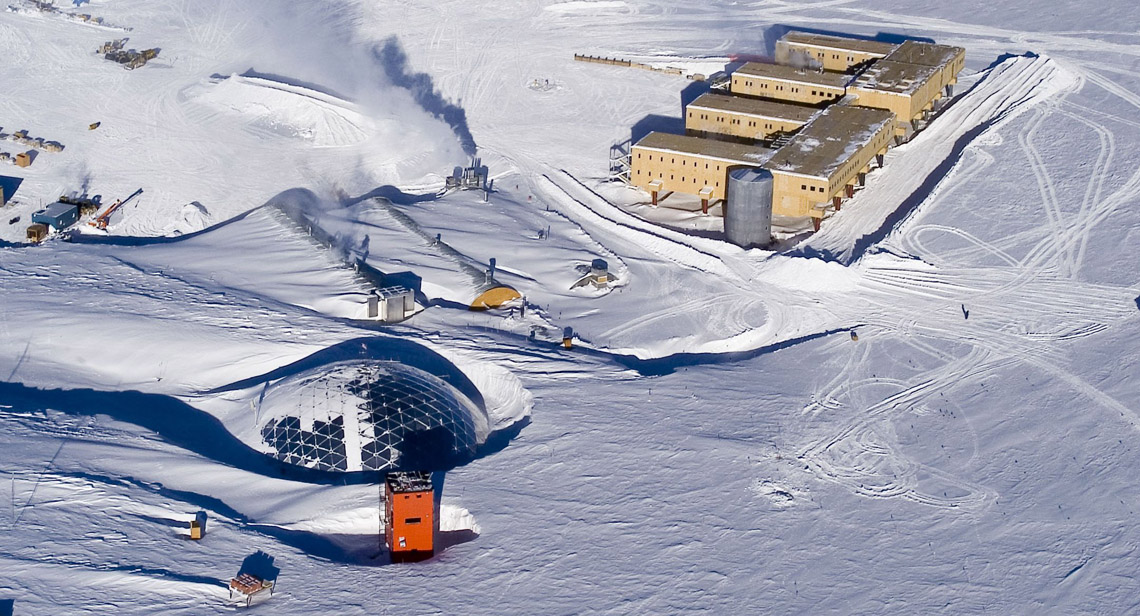
This 2005 photo shows the new station (top right) and the old dome (bottom left) To meet the challenge of drifting snow, the new station is designed with the profile of a sleek airplane wing. It is elevated and faces into the prevailing near-constant 10 to 15 mph wind, which flows above and below the station. The fast-moving winds beneath the station effectively help scour the area of snow, thereby greatly reducing the need for manual excavation. However, because some snow buildup is inevitable, the building also sits on 36 uniquely designed hydraulic jack columns that allow the 65,000-square-foot structure to be raised in 25-centimeter (10-inch) increments, thereby effectively adding decades to its building life.
Another problem involves the 'ground' supporting the structure. Actually, it sits on a glacier almost two miles deep that slides 33 feet toward the sea each year. (As a result, the marker designating the true geographic South Pole must be moved annually.) And because different parts of glaciers move at different speeds, buildings are in constant danger of being ripped apart. So the connecting walkways between building modules are designed to be flexible. To ease fuel consumption, the structure is insulated to five times the value of the average U.S. residence.
Finally, builders faced the challenge of getting nearly 40,000 tons of construction materials to a site that has no roads, railroads or other type of access infrastructure. The facility was designed so that all parts could be shipped in the cargo bay of ski-equipped LC-130 Hercules aircraft. The result is a city in miniature—which even includes a NASA plant-growth chamber to help augment supplies of fresh food. The W-shaped structure will accommodate NSF's Antarctic research program at the Pole, which includes 150 people during the three-month austral summer and 50 people during the remaining nine months. -by Peter West
New NSF Station Photo Gallery
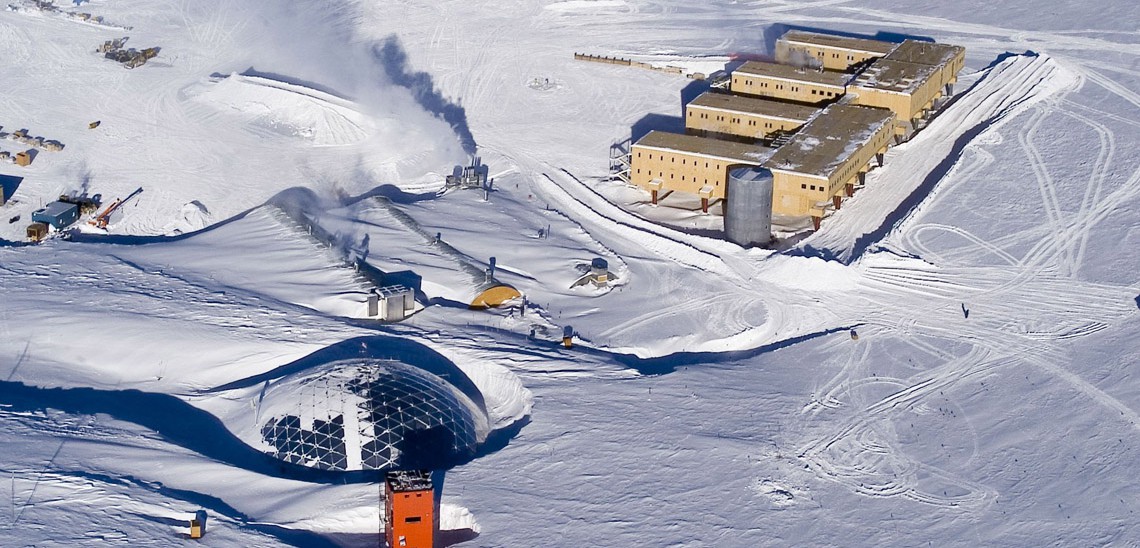 This aerial photo from October of 2005 shows the new South Pole station (without its final outer layers) in the upper right portion of the frame. The old station is the geodesic dome at lower left.
This aerial photo from October of 2005 shows the new South Pole station (without its final outer layers) in the upper right portion of the frame. The old station is the geodesic dome at lower left.
Credit: Scot Jackson, NSF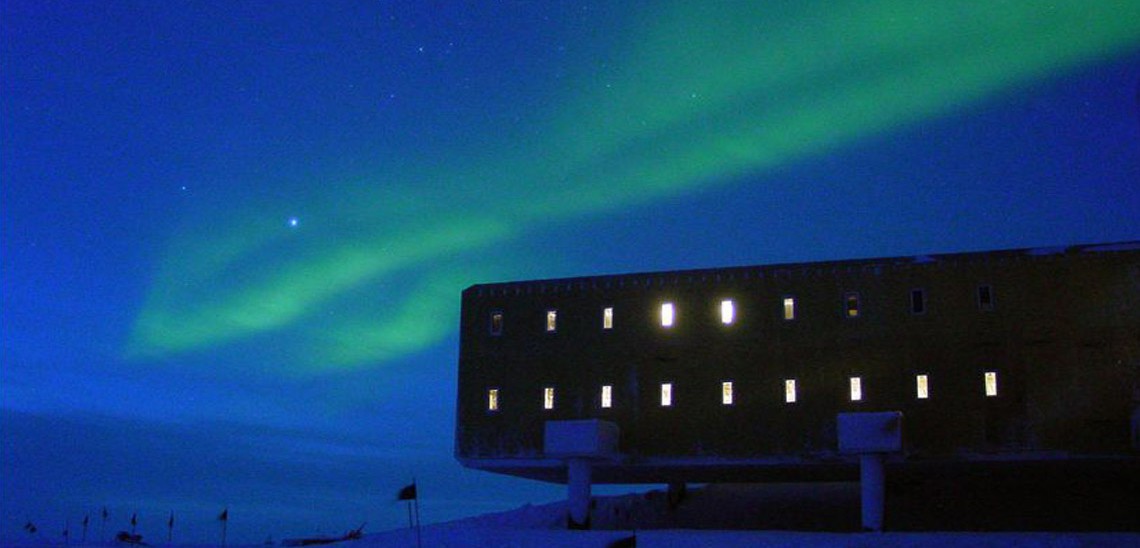 The aurora australis - the southern-hemisphere equivalent of the Northern Lights - glows over the new South Pole Station.
The aurora australis - the southern-hemisphere equivalent of the Northern Lights - glows over the new South Pole Station.
Credit: Jonathan Berry, USAP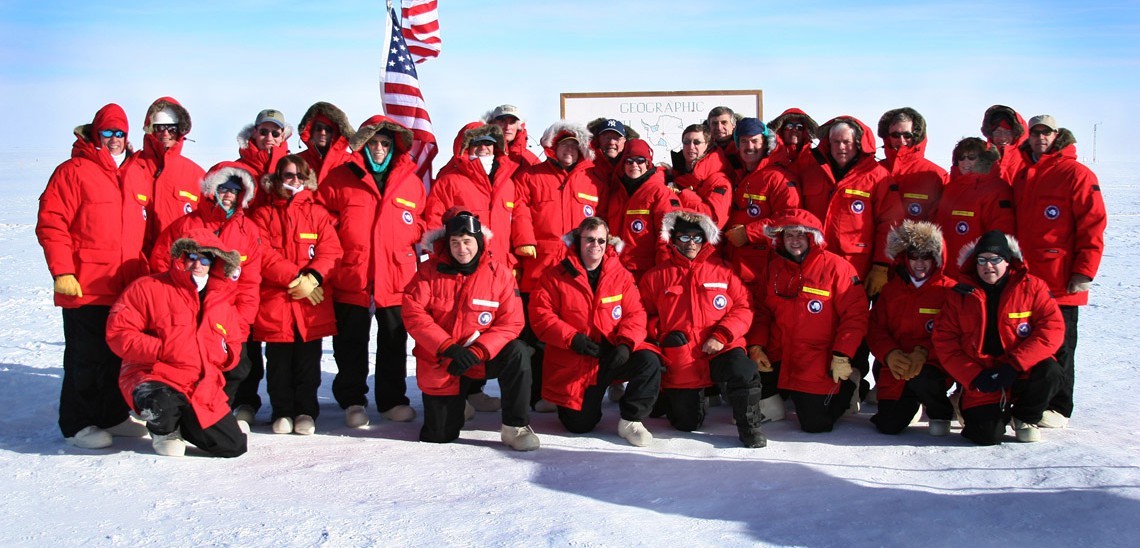 In January of 2006, South Pole Station hosted a congressional delegation that included: Sens. John McCain (R-AZ), Susan Collins (R-ME), and John Sununu (R-NH); and Reps Sherwood Boehlert (R-NY), Roscoe Bartlett (R-MD), Bob Inglis (R-SC), Phil Gingrey (R-GA), Darlene Hooley (D-OR), Robert Cramer (D-AL), Lincoln Davis (D-TN), Brad Miller (D-NC), Jim Costa (D-CA), Ben Chandler (D-KY) and Air Force Under Secretary Ronald Sega. NSF Deputy Director Kathie Olsen is at top row, center.
In January of 2006, South Pole Station hosted a congressional delegation that included: Sens. John McCain (R-AZ), Susan Collins (R-ME), and John Sununu (R-NH); and Reps Sherwood Boehlert (R-NY), Roscoe Bartlett (R-MD), Bob Inglis (R-SC), Phil Gingrey (R-GA), Darlene Hooley (D-OR), Robert Cramer (D-AL), Lincoln Davis (D-TN), Brad Miller (D-NC), Jim Costa (D-CA), Ben Chandler (D-KY) and Air Force Under Secretary Ronald Sega. NSF Deputy Director Kathie Olsen is at top row, center.
Credit: Steven Profaizer, NSF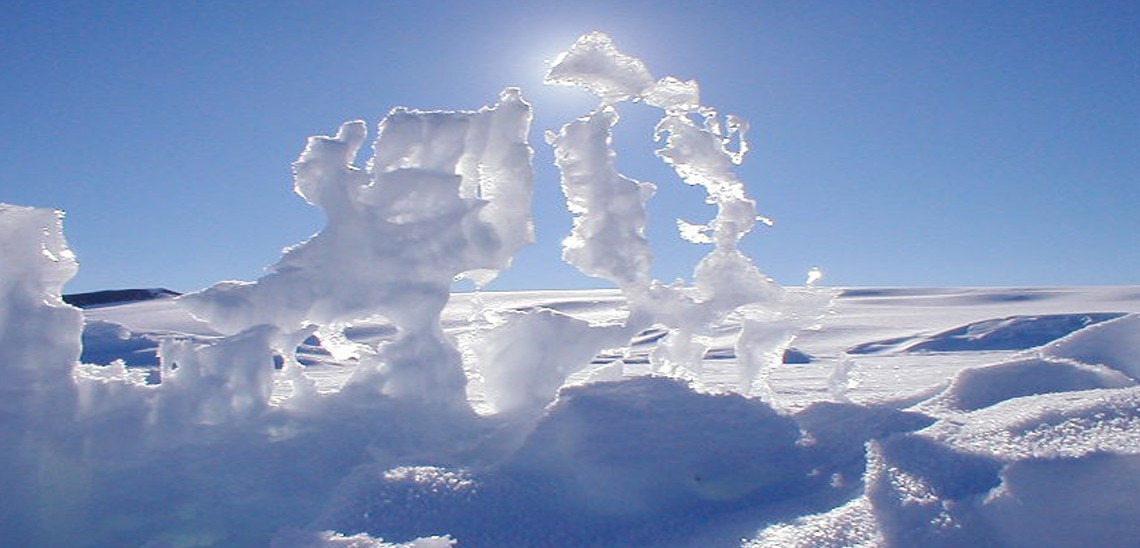 On the wind-blasted surface around the South Pole, snow can take on delicate and fascinating shapes.
On the wind-blasted surface around the South Pole, snow can take on delicate and fascinating shapes.
Credit: National Science Foundation, USAP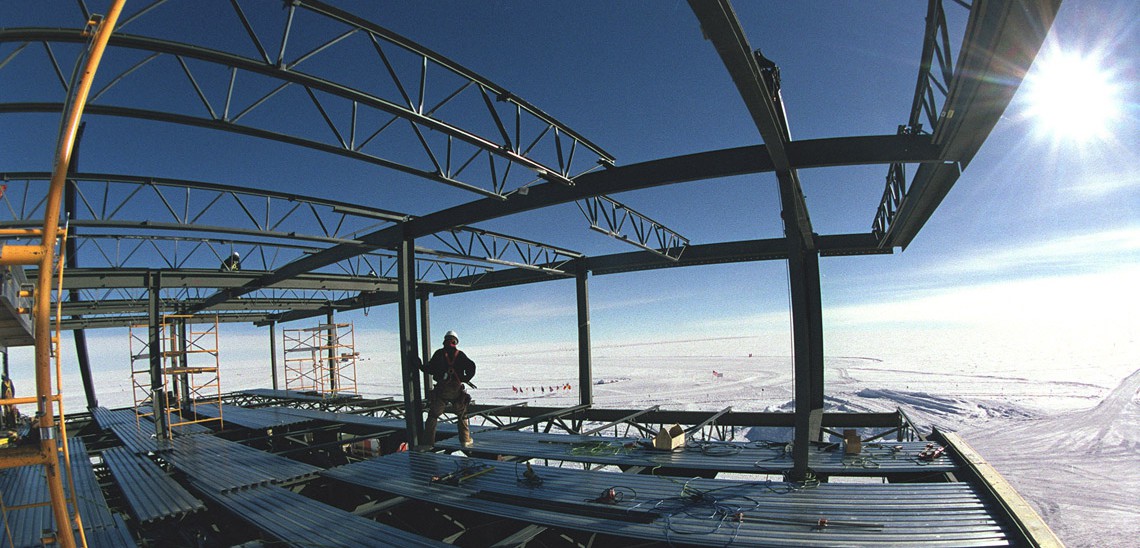 Workers erect steel girders on the first wing of the new, elevated South Pole station. Work began on the first wing of the station in the fall of 1999. Both the ceremonial South Pole, with its circle of flags from Antarctic Treaty nations, and the geographic South Pole are visible at the center background of the picture.
Workers erect steel girders on the first wing of the new, elevated South Pole station. Work began on the first wing of the station in the fall of 1999. Both the ceremonial South Pole, with its circle of flags from Antarctic Treaty nations, and the geographic South Pole are visible at the center background of the picture.
Credit: e. Mastroianni, Milwaukee Journal Sentinel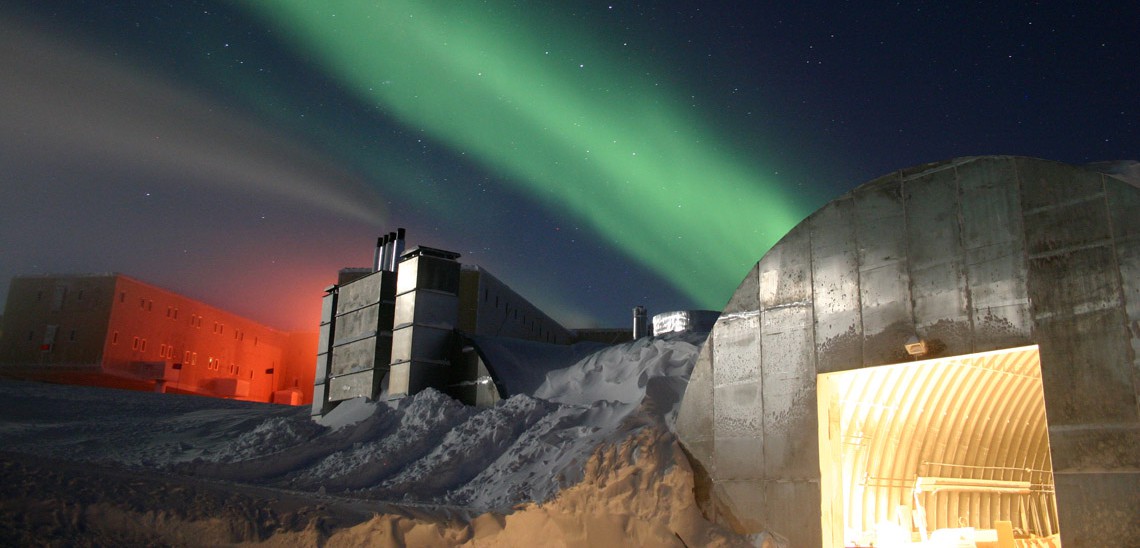 A full moon and 25-second exposure makes the South Pole station visible in the July 2005 image during the 6-month-long Antarctic night. The new station can be seen at far left, power plant in the center and the old mechanic's garage at lower right. Red lights are used outside during the winter as their spectrum does not pollute the sky, allowing scientists to conduct astrophysical studies without artificial light interference. The green light in the sky is the aurora australis.
A full moon and 25-second exposure makes the South Pole station visible in the July 2005 image during the 6-month-long Antarctic night. The new station can be seen at far left, power plant in the center and the old mechanic's garage at lower right. Red lights are used outside during the winter as their spectrum does not pollute the sky, allowing scientists to conduct astrophysical studies without artificial light interference. The green light in the sky is the aurora australis.
Credit: Chris Danals, NSF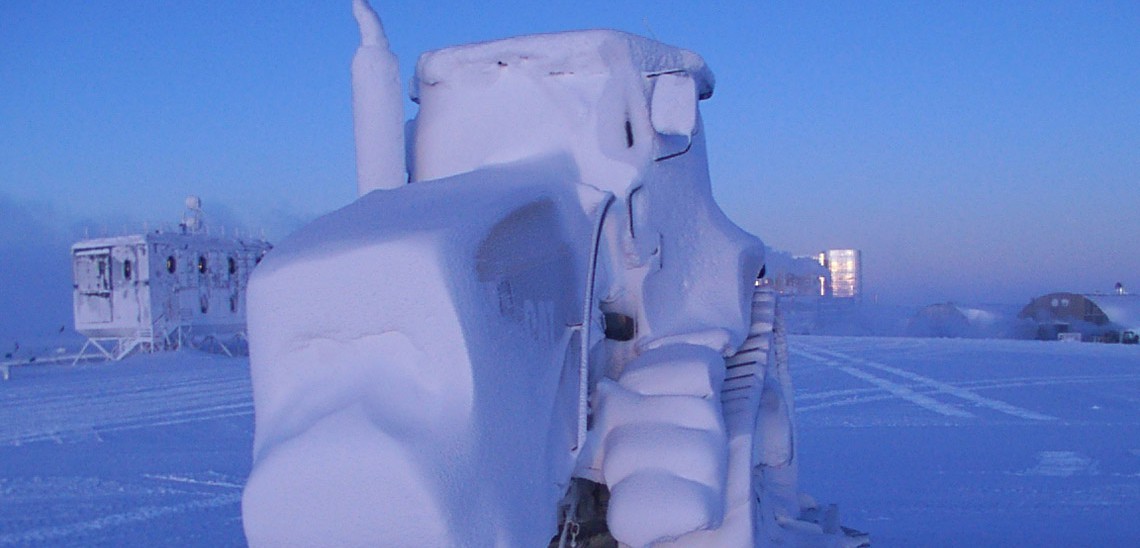 A tractor at Amundsen-Scott South Pole Station is completely encased in snow after sitting idle all winter.
A tractor at Amundsen-Scott South Pole Station is completely encased in snow after sitting idle all winter.
Credit: Jon Martin, NSF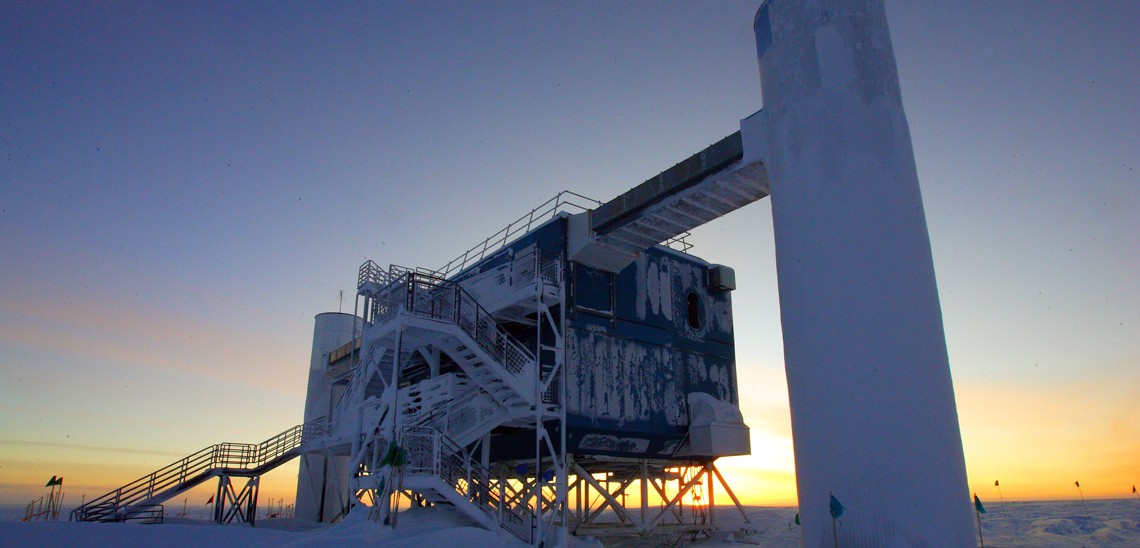 Workers at Amundsen-Scott South Pole Station jack up the new structure in increments to bring the sections level with each other. The new station's adjustable height and raised foundation will keep it from being covered by snow, as is the case with its domed predecessor.
Workers at Amundsen-Scott South Pole Station jack up the new structure in increments to bring the sections level with each other. The new station's adjustable height and raised foundation will keep it from being covered by snow, as is the case with its domed predecessor.
Credit: Melanie Conner, NSF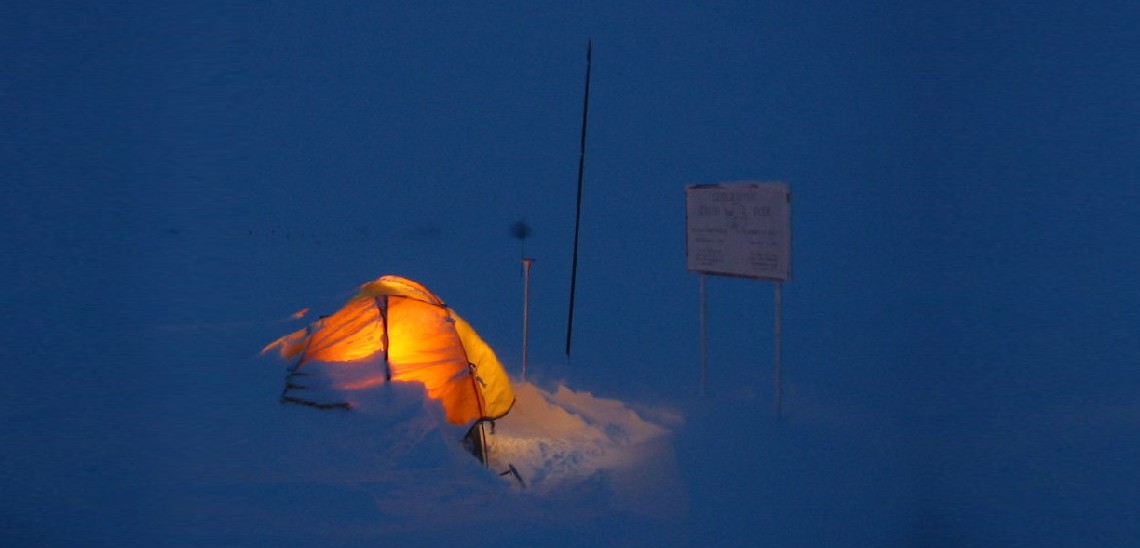 A hardy camper inhabits a tent erected a few feet from the South Pole marker in the September of 2004.
A hardy camper inhabits a tent erected a few feet from the South Pole marker in the September of 2004.
Credit: Julienne Harnett, Harvard-Smithsonian Center for Astrophysics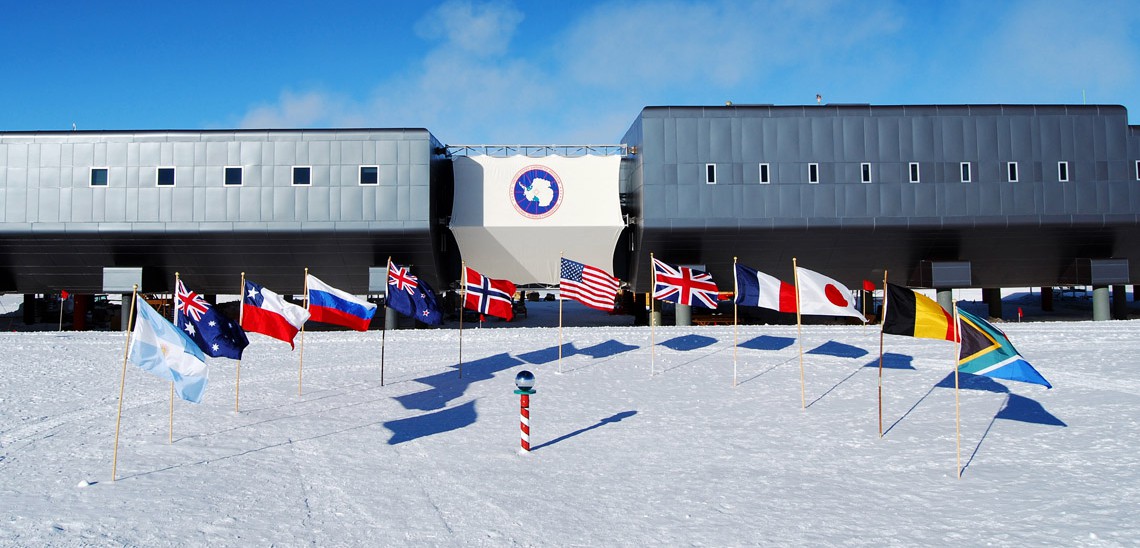 The geographic pole marker indicates exactly 90 degrees South. But the ice sheet over the pole moves approximately seven meters every year. So the marker must be repositioned annually. Previous years' markers are left standing for a few years, illustrating the motion of the ice sheet, Participants wintering at the South Pole design and create the unique markers for each year. The 5-inch, brass and aluminum marker has 86 dimples on the perimeter - one for each member of the 2005 winter-over South Pole crew.
The geographic pole marker indicates exactly 90 degrees South. But the ice sheet over the pole moves approximately seven meters every year. So the marker must be repositioned annually. Previous years' markers are left standing for a few years, illustrating the motion of the ice sheet, Participants wintering at the South Pole design and create the unique markers for each year. The 5-inch, brass and aluminum marker has 86 dimples on the perimeter - one for each member of the 2005 winter-over South Pole crew.
Credit: Joe Tarnow, NSF South Pole station offers relatively few diversions, and meals are hugely important to the quality of life for the scientists and others. The food is both appetizing and abundant for good reason: a person working outdoors can burn off 5,000 to 6,000 calories per day. That's two or three times the normal requirement for an average American with a desk job.
South Pole station offers relatively few diversions, and meals are hugely important to the quality of life for the scientists and others. The food is both appetizing and abundant for good reason: a person working outdoors can burn off 5,000 to 6,000 calories per day. That's two or three times the normal requirement for an average American with a desk job.
Credit: Peter West, NSF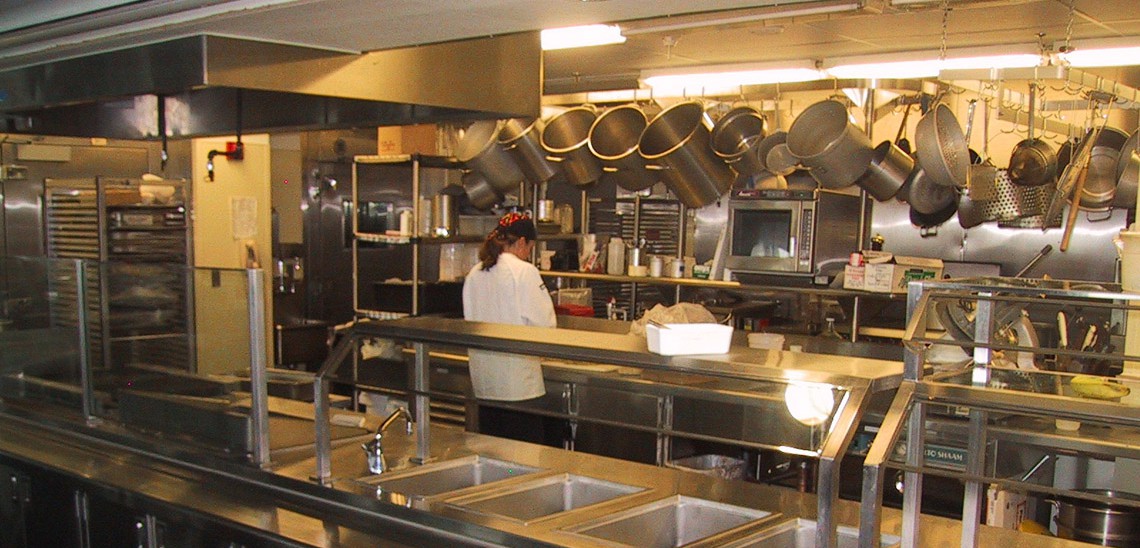 In this 2003 photo of the kitchen facilities at the new South Pole station, a cook works amid the gleaming fixtures and implements. Thirteen people are hired each season to help feed the growing South Pole population.
In this 2003 photo of the kitchen facilities at the new South Pole station, a cook works amid the gleaming fixtures and implements. Thirteen people are hired each season to help feed the growing South Pole population.
Credit: Jon Emanuel, NSF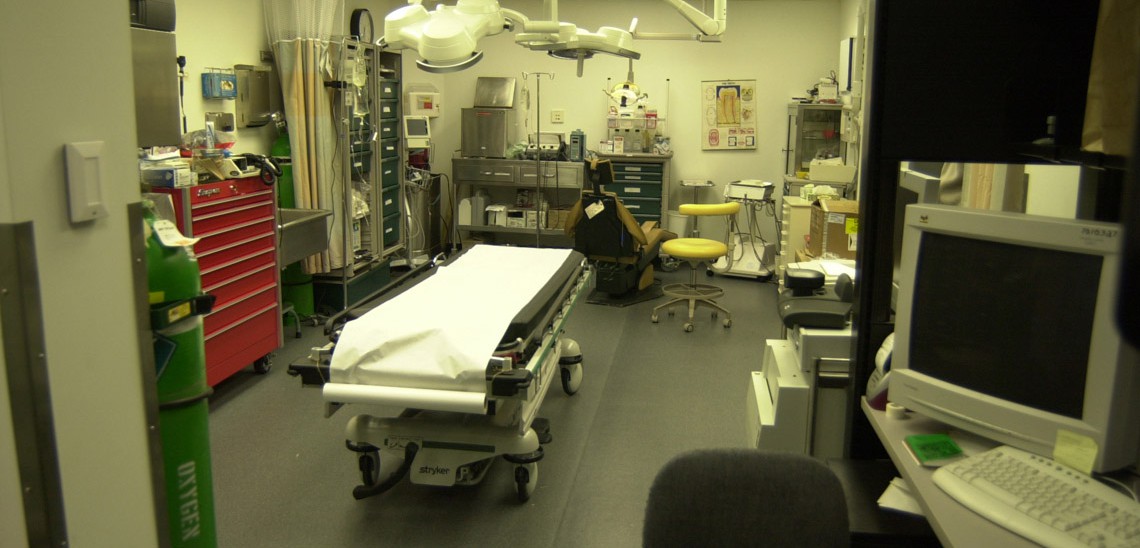 The new medical center at Amundsen-Scott South Pole Station features equipment found in modern emergency rooms and dental offices. The facility also includes a recovery room and provisions for "telemedicine" consults via uplinks to doctors elsewhere.
The new medical center at Amundsen-Scott South Pole Station features equipment found in modern emergency rooms and dental offices. The facility also includes a recovery room and provisions for "telemedicine" consults via uplinks to doctors elsewhere.
Credit: Brien Barnett, NSF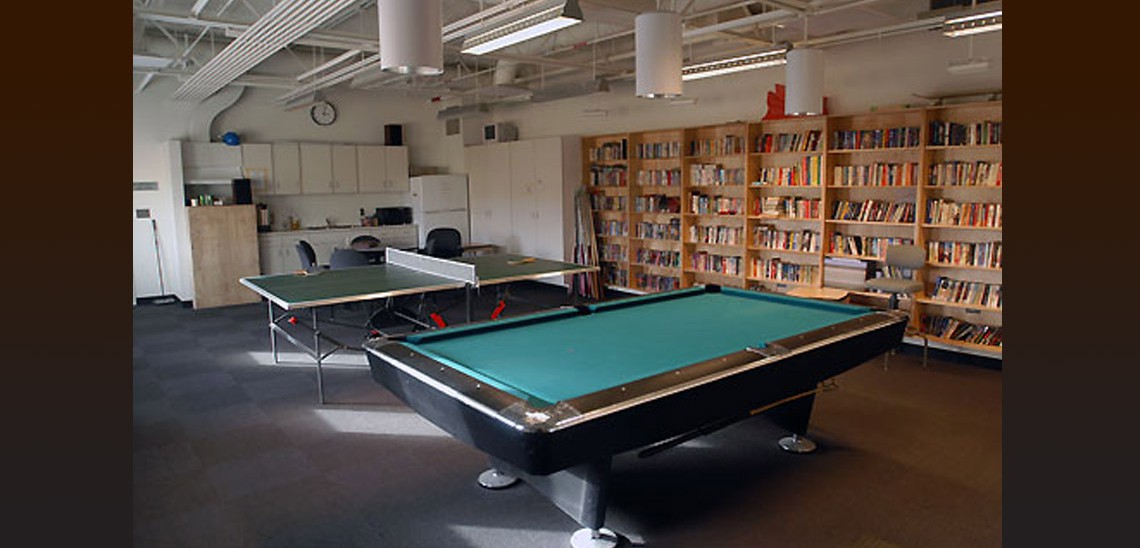 Free time is a fairly rare item at South Pole station. But when the opportunity arises, there is a new recreation room that can accommodate of host of different activities.
Free time is a fairly rare item at South Pole station. But when the opportunity arises, there is a new recreation room that can accommodate of host of different activities.
Credit: Peter West, NSF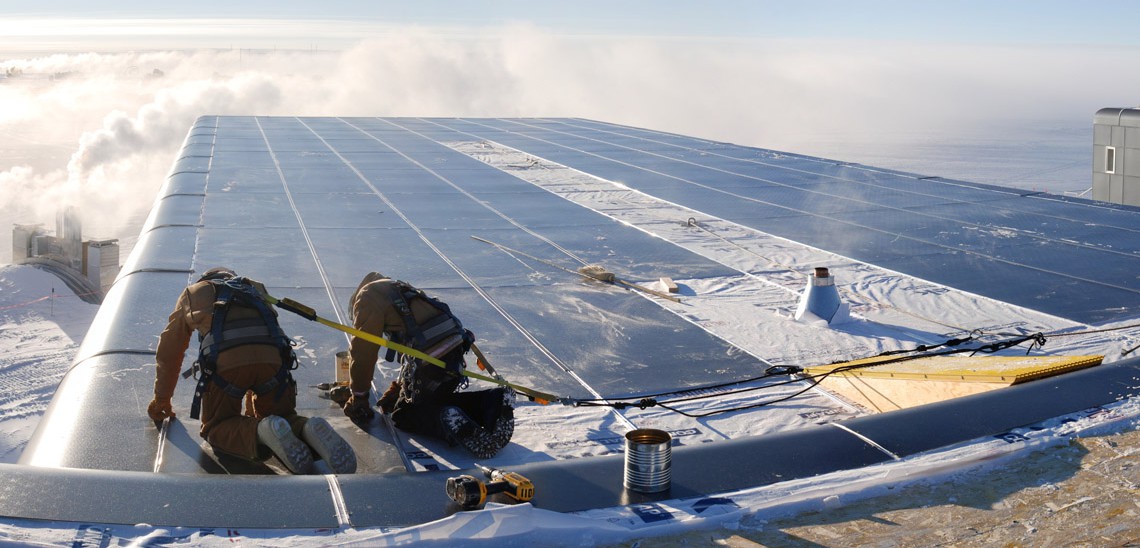 This image from February 2006 shows the new South Pole station with siding in place on some of the walls. Eventually, the entire facility will be covered in dark, heat-absorbing siding.
This image from February 2006 shows the new South Pole station with siding in place on some of the walls. Eventually, the entire facility will be covered in dark, heat-absorbing siding.
Credit: Jordan A. Goodman, University of Maryland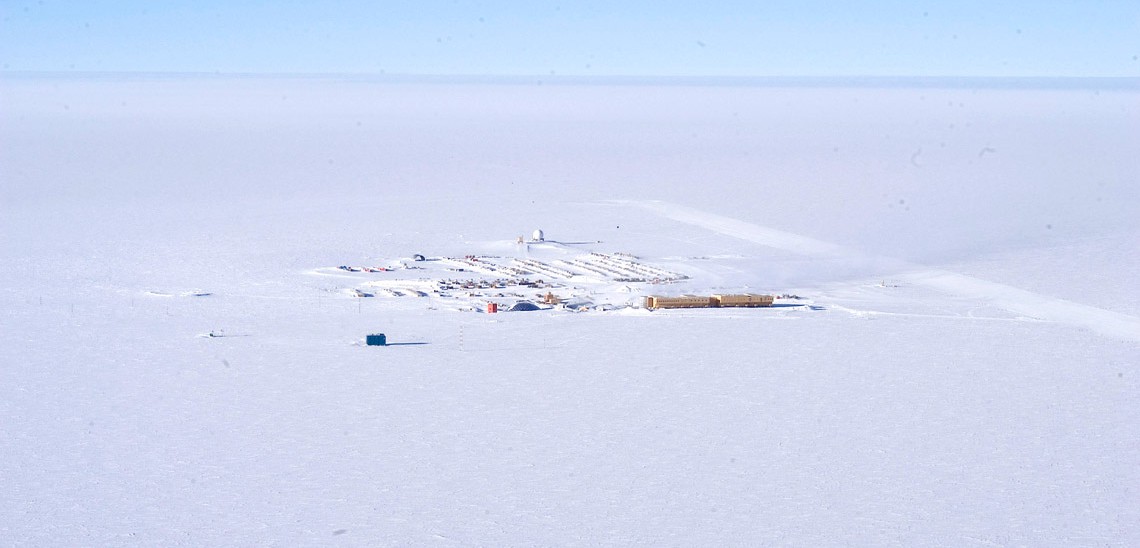 The U.S. South Pole Station is isolated on an otherwise empty expanse of ice that extends for hundreds of miles. The nearest human habitation is about 900 miles away, at McMurdo Station on Ross Island. The new facility at the South Pole will allow about 50 people to "winter over" during the period from March to October.
The U.S. South Pole Station is isolated on an otherwise empty expanse of ice that extends for hundreds of miles. The nearest human habitation is about 900 miles away, at McMurdo Station on Ross Island. The new facility at the South Pole will allow about 50 people to "winter over" during the period from March to October.
Credit: Scot Jackson, NSF
Any opinions, findings, conclusions or recommendations presented in this material are only those of the presenter grantee/researcher, author, or agency employee; and do not necessarily reflect the views of the National Science Foundation.

